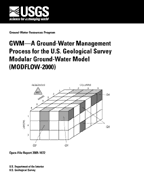

 |
GWM—A Ground–Water Management Process for the U.S. Geological Survey Modular Ground–Water Model (MODFLOW–2000)By David P. Ahlfeld (University of Massachusetts), Paul M. Barlow, and Ann E. Mulligan (Woods Hole Oceanographic Institution)Ground–Water Resources ProgramOpen–File Report 2005–1072 |
This report is presented in Portable Document Format (PDF).
Printable tabloid cover (104 KB)--1 page
Left inside cover (17 KB)--1 page
Right inside cover (14 KB)--1 page
Report (1.2 MB)--130 pages
The citation for this report, in USGS format, is as follows:
Ahlfeld, D.P., Barlow, P.M., and Mulligan, A.E., 2005, GWM—A ground–water management process for the U.S. Geological Survey modular ground–water model (MODFLOW–2000): U.S. Geological Survey Open–File Report 2005–1072, 124 p.
This report describes a Ground–Water Management Process (GWM) for the U.S. Geological Survey modular three–dimensional ground–water model, MODFLOW–2000. The performance of the program has been tested in a variety of applications. Future applications, however, might reveal errors that were not detected in the test simulations. Users are requested to notify the U.S. Geological Survey of any errors found in this report or the computer program by using the address on the inside of the back cover of the report. Updates might occassionally be made to both the report and to the computer program. Users can check for updates on the Internet at URL http://water.usgs.gov/software/ground_water.html/.
GWM is a Ground–Water Management Process for the U.S. Geological Survey modular three–dimensional ground–water model, MODFLOW–2000. GWM uses a response–matrix approach to solve several types of linear, nonlinear, and mixed–binary linear ground–water management formulations. Each management formulation consists of a set of decision variables, an objective function, and a set of constraints. Three types of decision variables are supported by GWM: flow–rate decision variables, which are withdrawal or injection rates at well sites; external decision variables, which are sources or sinks of water that are external to the flow model and do not directly affect the state variables of the simulated ground–water system (heads, streamflows, and so forth); and binary variables, which have values of 0 or 1 and are used to define the status of flow–rate or external decision variables. Flow–rate decision variables can represent wells that extend over one or more model cells and be active during one or more model stress periods; external variables also can be active during one or more stress periods. A single objective function is supported by GWM, which can be specified to either minimize or maximize the weighted sum of the three types of decision variables. Four types of constraints can be specified in a GWM formulation: upper and lower bounds on the flow–rate and external decision variables; linear summations of the three types of decision variables; hydraulic–head based constraints, including drawdowns, head differences, and head gradients; and streamflow and streamflow–depletion constraints.
The Response Matrix Solution (RMS) Package of GWM uses the Ground–Water Flow Process of MODFLOW to calculate the change in head at each constraint location that results from a perturbation of a flow–rate variable; these changes are used to calculate the response coefficients. For linear management formulations, the resulting matrix of response coefficients is then combined with other components of the linear management formulation to form a complete linear formulation; the formulation is then solved by use of the simplex algorithm, which is incorporated into the RMS Package. Nonlinear formulations arise for simulated conditions that include water–table (unconfined) aquifers or head–dependent boundary conditions (such as streams, drains, or evapotranspiration from the water table). Nonlinear formulations are solved by sequential linear programming; that is, repeated linearization of the nonlinear features of the management problem. In this approach, response coefficients are recalculated for each iteration of the solution process. Mixed–binary linear (or mildly nonlinear) formulations are solved by use of the branch and bound algorithm, which is also incorporated into the RMS Package.
Three sample problems are provided to demonstrate the use of GWM for typical ground–water flow management problems. These sample problems provide examples of how GWM input files are constructed to specify the decision variables, objective function, constraints, and solution process for a GWM run. The GWM Process runs with the MODFLOW–2000 Global and Ground–Water Flow Processes, but in its current form GWM cannot be used with the Observation, Sensitivity, Parameter–Estimation, or Ground–Water Transport Processes. The GWM Process is written with a modular structure so that new objective functions, constraint types, and solution algorithms can be added.
Abstract
Introduction
Numerical Modeling of Ground–Water Flow with MODFLOW
Formulation of Ground–Water Management Problems with GWM
Decision Variables
Flow–Rate Decision Variables
External Decision Variables
Binary Variables
Objective Function
Constraints
Decision–Variable Constraints
Linear–Summation Constraints
Hydraulic–Head Constraints
Streamflow Constraints
Complete Statement of Ground–Water Management Formulation Solved by GWM
Solution of Ground–Water Management Problems with GWM
Linear Formulations
Calculation of Response Coefficients
Accuracy and Precision of the Response Coefficients
Simplex Algorithm
Nonlinear Formulations
Mixed–Binary Linear Formulations
Input Instructions and Output Files
Name File
GWM Process Files
Description of Selected Conventions, Options, and Variables in GWM
GWM File
Decision variables (DECVAR) File
Objective Function (OBJFNC) File
Constraint Files
Decision–Variable Constraints (VARCON) File
Linear–Summation Constraints (SUMCON) File
Head Constraints (HEDCON) File
Streamflow Constraints (STRMCON) File
Solution and Output–Control Parameters (SOLN) File
Output Files
Sample Problems
Sample Problem 1: DEWATER
Linear Formulation
Mixed–Binary Linear Formulation
Selected Input and Output Files for Sample Problem
Sample Problem 2: SEAWATER
Nonlinear Formulation
Selected Input and Output Files for Sample Problem
Sample Problem 3: SUPPLY
Nonlinear Formulation
Selected Input and Output Files for Sample Problem
Acknowledgments
References Cited
Appendix 1. Examples of Decision Variables that can be Defined in GWM
Appendix 2. GWM Solution Algorithms
Appendix 3. Programmers’ Guide to GWM
1.Schematic graph showing seepage rate through a streambed as a function of ground–water head in a model cell
2–5.Schematic illustrations showing:
2.Types of hydraulic–head constraints supported by GWM
3.Model grid for DEWATER sample problem
4.Model grid for SEAWATER sample problem
5.Model grid for SUPPLY sample problem
| AccessibilityFOIAPrivacyPolicies and Notices | |
 |
|